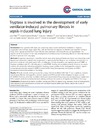Identificador persistente para citar o vincular este elemento:
https://accedacris.ulpgc.es/jspui/handle/10553/41628
| Campo DC | Valor | idioma |
|---|---|---|
| dc.contributor.author | Villar, Jesús | en_US |
| dc.contributor.author | Cabrera-Benítez, Nuria E. | en_US |
| dc.contributor.author | Valladares, Francisco | en_US |
| dc.contributor.author | García-Hernández, Sonia | en_US |
| dc.contributor.author | Ramos-Nuez, Ángela | en_US |
| dc.contributor.author | Martín Barrasa, José Luis | en_US |
| dc.contributor.author | Muros, Mercedes | en_US |
| dc.contributor.author | Kacmarek, Robert M. | en_US |
| dc.contributor.author | Slutsky, Arthur S. | en_US |
| dc.date.accessioned | 2018-07-23T10:30:28Z | - |
| dc.date.available | 2018-07-23T10:30:28Z | - |
| dc.date.issued | 2015 | en_US |
| dc.identifier.issn | 1466-609X | en_US |
| dc.identifier.uri | https://accedacris.ulpgc.es/handle/10553/41628 | - |
| dc.description.abstract | Most patients with sepsis and acute lung injury require mechanical ventilation to improve oxygenation and facilitate organ repair. Mast cells are important in response to infection and resolution of tissue injury. Since tryptase secreted from mast cells has been associated with tissue fibrosis, we hypothesized that tryptase would be involved in the early development of ventilator-induced pulmonary fibrosis in a clinically relevant model of sepsis-induced lung injury. | en_US |
| dc.language | eng | en_US |
| dc.relation.ispartof | Critical Care | en_US |
| dc.source | Critical Care [ISSN 1466-609X], v. 19 (1), p. 138 | en_US |
| dc.subject | 3109 Ciencias veterinarias | en_US |
| dc.subject | 320508 Enfermedades pulmonares | en_US |
| dc.subject.other | Lung injury | en_US |
| dc.subject.other | Acute lung injury | en_US |
| dc.subject.other | Acute respiratory distress syndrome | en_US |
| dc.subject.other | Tryptase | en_US |
| dc.subject.other | Acute respiratory distress syndrome patient | en_US |
| dc.title | Tryptase is involved in the development of early ventilator-induced pulmonary fibrosis in sepsis-induced lung injury | en_US |
| dc.type | info:eu-repo/semantics/article | en_US |
| dc.type | Article | es |
| dc.identifier.doi | 10.1186/s13054-015-0878-9 | en_US |
| dc.identifier.pmid | 25871971 | - |
| dc.identifier.scopus | 2-s2.0-84926666978 | - |
| dc.identifier.isi | 000352354600001 | - |
| dc.identifier.url | https://api.elsevier.com/content/abstract/scopus_id/84926666978 | - |
| dc.identifier.eissn | 1466-609X | - |
| dc.identifier.issue | 1 | - |
| dc.description.firstpage | 138 | - |
| dc.relation.volume | 19 | - |
| dc.investigacion | Ciencias de la Salud | en_US |
| dc.type2 | Artículo | en_US |
| dc.identifier.ulpgc | Sí | es |
| dc.description.jcr | 4,95 | |
| dc.description.jcrq | Q1 | |
| dc.description.scie | SCIE | |
| item.fulltext | Con texto completo | - |
| item.grantfulltext | open | - |
| crisitem.author.dept | GIR IUSA-ONE HEALTH 2 - Sanidad Animal de la Acuicultura y Especies Silvestres, Enfermedades Infecciosas y Seguridad Alimentaria | - |
| crisitem.author.dept | IU de Sanidad Animal y Seguridad Alimentaria | - |
| crisitem.author.dept | Departamento de Patología Animal, Producción Animal, Bromatología y Tecnología de Los Alimentos | - |
| crisitem.author.orcid | 0000-0002-3280-9838 | - |
| crisitem.author.parentorg | IU de Sanidad Animal y Seguridad Alimentaria | - |
| crisitem.author.fullName | Martín Barrasa, José Luis | - |
| Colección: | Artículos | |
Citas SCOPUSTM
20
actualizado el 08-jun-2025
Citas de WEB OF SCIENCETM
Citations
21
actualizado el 12-ene-2026
Visitas
53
actualizado el 11-ene-2026
Descargas
74
actualizado el 11-ene-2026
Google ScholarTM
Verifica
Altmetric
Comparte
Exporta metadatos
Los elementos en ULPGC accedaCRIS están protegidos por derechos de autor con todos los derechos reservados, a menos que se indique lo contrario.
